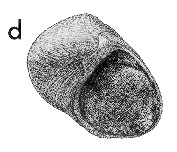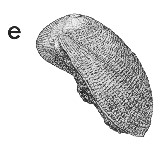
Revised descriptions of New Zealand Cenozoic Mollusca from Beu and Maxwell (1990)

 | Revised descriptions of New Zealand Cenozoic Mollusca from Beu and Maxwell (1990) | 
|
  (Pl. 6d): holotype, Maerewhenua River, near Livingstone, North Otago, Bortonian (TM6854, GNS) |
  (Pl. 6e): holotype, Maerewhenua River, near Livingstone, North Otago, Bortonian (TM6854, GNS) |
Beu & Maxwell (1990): Chapter 7; p. 105; pl. 6 d, e.
Synonymy: Sinum fornicatum Suter, 1917, p. 11; Sigaretotrema fornicatum; S. insociale Marwick 1960, p. 20; Propesinum fornicatum, Beu & Maxwell 1990, p. 105, pl. 6d, e.
Classification: Naticidae: Poliniceinae
Description: Rather small for family (height 9-16 mm); auriform, spire low, subcorneal. Protoconch subplanorboid, of about 3 smooth whorls. Teleoconch of 1-1.5 rapidly increasing whorls; spire whorls convex, last whorl with well rounded periphery, base concave, narrowly umbilicate. Sutures scarcely impressed. Axial sculpture of growth lines, spiral sculpture of narrow, rounded or flat-topped cords with interstitial threads, interrupted by growth lines, more prominent on spire than on base. Aperture ovate, very large, strongly prosocline, outer lip inclined at about 30° to vertical; basal lip shallowly excavated. Parietal callus narrow, moderately thick; inner lip reflected over upper part of umbilicus.
Comparison: Eunaticina fornicata is similar to Eunaticina papilla (Pl. 47s) but differs in having a much lower spire, a slightly lower protoconch, a scarcely impressed suture, more rapidly expanding teleoconch whorls, a narrower umbilicus and a much more oblique aperture. Sinum insociale allegedly differs from E. fornicata in having a less oblique aperture, but the holotype of S. insociale (the only known specimen) is a small, poorly preserved specimen that seems to have the outer lip as oblique as typical specimens of E. fornicata. Although long referred to Sigaretotrema, this species has little resemblance to the type species, S. michaudi (Michelotti, 1847) (Miocene, Europe), which has a globular, high-spired shell with a moderately oblique aperture. It is, however, similar to the type species of Propesinum Iredale, 1924, P. umbilicatum (Quoy and Gaimard, 1832) (Recent, Tasmania) and very similar to tropical Indo-West Pacific species of Eunaticina, and seems best placed in Eunaticina, along with E. auriformis (Marwick, 1924) (Wangaloa) and E. papilla (Maxwell 2009, p. 242).
Distribution: Mangaorapan — Bortonian; Bortonian, Maerewhenua River, North Otago (type of S. fornicatum); Otaio Gorge (type of S. insociale); Kakahu; South Branch Waihao River near "Pentland Hills". Rather rare at all localities.
Cite this publication as: "A.G. Beu and J.I. Raine (2009). Revised
descriptions of New Zealand Cenozoic Mollusca from Beu and Maxwell (1990). GNS
Science miscellaneous series no. 27."
© GNS Science, 2009
ISBN
978-0-478-19705-1
ISSN 1177-2441
(Included with a PDF facsimile file
copy of New Zealand Geological Survey Paleontological Bulletin 58 in CD version
from: Publications Officer, GNS Science, P.O. Box 30368 Lower Hutt, New
Zealand)